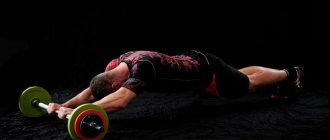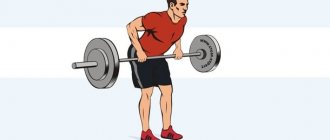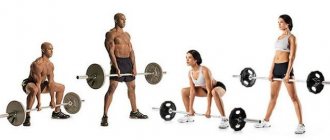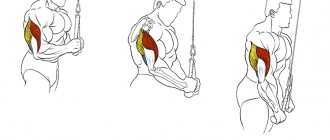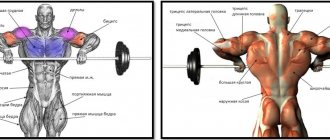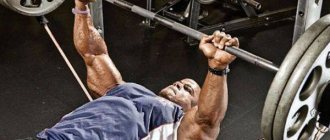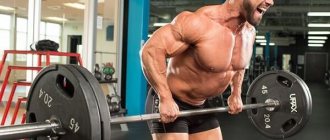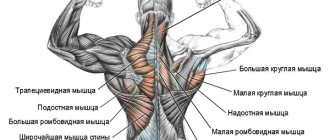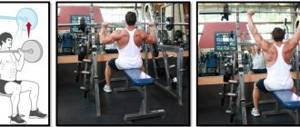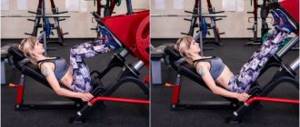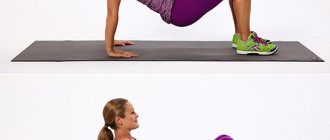- October 30, 2018
- Workouts in the gym
- Nikita Novikov
Types of bars is a topic that, unfortunately, does not receive enough attention when discussing sports equipment and accessories. As a rule, most average fitness center goers, at best, only know about a standard bar and perhaps an EZ curved barbell. Not everyone thinks about the fact that the shape, design and weight of the bar in the gym determines how effective this or that exercise will be. In today’s publication, we will take a closer look at what types of barbells there are and how to use them in the training process.
Weight
When discussing what types of barbells there are, one cannot help but touch upon the topic of the weight of this apparatus. Its weight directly depends on its size - the longer it is, the heavier it is. On average, the weight of a metal rod for a barbell ranges from 6 to 30 kilograms. Particular attention should be paid to the locks that are attached to both sides of the bar to secure the pancakes. The standard weight of locks is 2.5 kilograms.
As already noted, there are many types of vultures. Each of them differs in size, weight and functionality. How many varieties of vultures are there? What are their names? Which one is the best?
Olympic bar
This metal barbell rod is the most popular among athletes. Such a bar can be found in almost every gym, even the most sparsely equipped. Since almost all visitors to fitness centers have been using this rod for decades, it is also called classic.
This equipment can be used for strength training in almost any sport. The weight of an Olympic barbell is 20 kilograms and its length is 2.2 meters. The projectile has a thick base of 28 millimeters, and the diameter of its movable ends, on which pancakes are hung, is 50 millimeters. This design is necessary to adjust the center of gravity during the jerk of the barbell. As a rule, in bodybuilding, the Olympic bar is used in basic exercises: bench press in a horizontal position, military press, squats, etc. The weight limit is 320 kilograms.
Powerlifting bar
As you might have guessed from the name, this type of barbell is designed for working with very heavy weights. This projectile can withstand weights weighing 600 kilograms, which is almost twice as much as the previous version. Powerlifting bars are made from high-strength steel so that they do not spring back under the weight of heavy weights. If we compare them with classic rods, they stand out for their thickness and strength.
The weight of this projectile is 30 kilograms. Shortened length - 2.05 meters. The diameter of the neck is 3 centimeters.
The creation and distribution of powerlifting bars is taken very seriously. The manufacturer of such equipment must conduct a special check and thereby assess the final quality of the resulting product. If the verification has been successfully completed, the product is given a special certificate, which is proof of its high quality. After completing these procedures, the bar can be used in practice - both in regular training and in professional competitions.
Neck dimensions
Length
The length of the bar depends on the exercises performed and training conditions. For example, a bar that is too short cannot be grasped with a wide grip for the bench press, while a bar that is too long can make it awkward to train indoors. The barbell has different lengths: 120, 140, 150, 180, 220 cm.
For comfortable and effective training at home, you will need a bar from 140 cm (with the length of the central part - 100 cm, the side parts for weight plates - 20 cm) to 180 cm. The bar for the Olympic barbell is 220 cm.
The length of the dumbbell bar also depends on the training conditions. It is impossible to put a large number of weights on a bar that is too short, which means increasing the load. A bar that is too long is inconvenient for many exercises. The bar of amateur dumbbells is 36 cm, the Olympic bar is 50 cm long.
Important: it is better to choose dumbbells with a rubberized handle (neck). This makes them pleasant to the touch and prevents them from slipping out of your hands. The bar has special notches that make the surface of the bar embossed and less slippery.
Diameter (thickness)
The diameter of the bar for an amateur barbell is 25 mm, for an Olympic barbell – 28 mm, for powerlifting – 29 mm.
The diameter of the bar (seat) for dumbbells in Europe and Russia is 30 mm, the American standard is 25 mm (for amateurs). The diameter of the seat of the bar of Olympic dumbbells is 50 mm.
Important: when purchasing a barbell and collapsible dumbbells, you should choose discs that are suitable for both equipment. To do this, you need to pay attention to the diameter of the barbells and dumbbells - it must be the same size. It should also be taken into account that the seat diameter of the pancakes is 1 mm larger than the diameter of the neck.
Weight
The weight of the bar depends on its length and diameter, as well as the density of the steel. A stronger bar has more weight and greater load capacity. The weight of the bar is also an additional burden for the athlete. The weight of the bar for an amateur barbell is 10-20 kg, for an Olympic barbell (powerlifting) - 20 kg, for a squat bar - 30 kg.
Important: the barbell for home training must have sufficient rigidity and not spring back when lifting heavy weights.
Standard neck
At first glance it may seem that it is no different from the Olympic one, but in reality this is not entirely true. The thickness of this type of bar is only 25 millimeters along its entire length, while its weight remains the same as in the classic one - 20 kilograms. It should be noted that such standard barbell rods often have a non-standard weight, ranging from 15 to 20 kilograms. Therefore, before performing any exercise with such a bar, it is better to check with the trainer what the weight of this apparatus is.
Type of rod
Home (amateur) barbell - has a short length and weight limits of up to 100-120 kg. Discs are used with a seat diameter of 25-26 mm. Well suited for amateur training with light weights. The advantage is a relatively low price.
“People’s” barbell – resembles “Olympic” bars, but can withstand up to 150 kg. Discs are used with a seat diameter of 50-51 mm. Not suitable for professional training.
Olympic barbell – used by professional athletes. It is manufactured using special technology and is characterized by increased strength. Withstands weights of 300, 500, 600 kg and above. Discs with a mounting hole diameter of 50-51 mm are used.
- The women's Olympic barbell differs from the men's barbell by having a shorter bar (205 cm), lighter weight (15 kg) and diameter (25 mm).
A powerlifting barbell looks like an Olympic barbell, but the diameter of the bar is 29 mm and it is much more rigid.
Dumbbells and weights are also divided into amateur and Olympic (professional). They differ mainly in weight.
Important: be sure to pay attention to the maximum permissible load for the bar and never exceed it.
Women's Olympic bar
The main difference between the women's straight Olympic bar and the previously described classic bar is the size and weight. The length of such a projectile reaches 2.05 meters, and its diameter is 2.5 centimeters. The standard weight of a women's Olympic bar is 15 kilograms. As you can see, the women's version is slightly lighter and shorter. Otherwise, the design of this projectile is no different from the classics. The women's Olympic bar is used both for performing the “base” (bench press, deadlift, squats) and for special exercises from women's Olympic sports.
Discs
Discs (plates) are additional weights that are placed on the barbell. They differ from each other in weight and diameter.
There are several types of disks.
Fitness discs are the most common. As a rule, they are painted black.
Olympic - used for professional sports. Discs of different weights differ from each other in color (red, green, yellow, black). There are the following types of such disks:
- rubberized models - absorb shock, are comfortable to hold in your hands and carry when changing weight;
- without rubber coating - used for powerlifting .
Diameter
The outer diameter is the size of the disc itself. Depends on its weight: the greater the weight, the larger the diameter.
Internal (landing) diameter - the size of the hole for the neck. The compatibility of the barbell and discs depends on this value. There are diameters of 26, 30 and 50-51 mm.
Weight
Barbell discs have different weights (0.25, 0.5, 0.75, 1.25, 2.5, 5, 10, 15, 20, 25, 50 kg). The most common are 2.5, 5 and 10 kilogram pancakes. In powerlifting, discs weighing 50 kg are used. Olympic bar discs are used by professional athletes and therefore have a particularly precise weight.
Important: for basic loads, you should purchase a pair of 20 kg disks, and then add weights of 1, 2.5, 5 and 10 kg. This will make it possible to smoothly increase or decrease the weight of the barbell.
It is inconvenient to use large diameter discs for dumbbells. Pancakes weighing no more than 5 kg are good. It is also recommended to have small disks of 0.5 and 1 kg in order to smoothly increase or decrease the load.
Curved and crooked necks
In bodybuilding, curved and bent metal rods for barbells are used for isolated training of small muscle groups, namely biceps, triceps and deltoids.
For example, the EZ bar is great for pumping up arm muscles. It is significantly shorter than other shells. It is very convenient to perform barbell curls, French bench press, and also curls on the Scott bench. Thanks to this curved shape of the bar, the forearms and wrist joint are practically excluded from work during the exercise. At the same time, most importantly, the target muscles fully receive the necessary load.
There is also a W-shaped neck. Some athletes find it more convenient and effective than the option described in the paragraph earlier. It is also good for working the arm and deltoid muscles.
Both the EZ-bar and the W-shaped bar are much shorter and lighter than other projectile options. On average, their length is 1.2 meters and their weight is 6.5 kilograms.
Particular attention should also be paid to the T-neck. This apparatus is designed exclusively for performing bent-over barbell rows - one of the most effective and popular exercises for pumping up the back muscles. The T-bar row is a more isolated and gentle exercise than the classic Olympic barbell row.
Universal neck
We have already figured out what types of barbells there are in the gym. Now let's look at the option of home training. For those who are going to make a small room at home, a universal projectile is best suited. This budget type of bar is created specifically for people who want to keep fit, but for certain reasons cannot visit fitness centers and gyms.
The diameter of this rod is almost the same as that of the classic one. The main advantage of this projectile is its low price. Otherwise, it is much inferior to other types of vultures. The main disadvantages include poor quality and low strength. In addition, it cannot withstand the loads that Olympic and powerlifting bars can withstand.
In total, there are four types of universal projectile:
- Weight - 10 kilograms, length - 2 meters.
- Weight - 8 kilograms, length - 1.8 meters.
- Weight - 7 kilograms, length - 1.5 meters.
- Weight - 6 kg, length - 1.25 meters.
Since it may not be entirely clear from just photos what a particular neck looks like, we recommend that you watch the video below. It explains in detail the types of barbell rods as well as their functional uses.
We looked at what types of bars there are for training in the gym or at home. Now you know the correct names of the equipment that you most often use in the training process.
Neck and disc material
The bar for a barbell (collapsible dumbbell) is made of metal. Olympic bars and powerlifting bars are made of high-strength steel and using special technology.
Metal disks are the simplest and cheapest option. However, they are susceptible to corrosion, can scratch the skin and deform the floor covering.
Metal discs with a rubber strip along the rim do not deform the floor, but are also susceptible to corrosion. Disadvantages: rubber has an unpleasant odor and can leave marks on the floor.
Metal discs completely covered with rubber/plastic are the best option: they are not subject to corrosion, do not deform the floor, and are durable. Disadvantages: high price, unpleasant smell of rubber and marks on the floor. In addition, the plastic may burst or crack if dropped on the floor.
